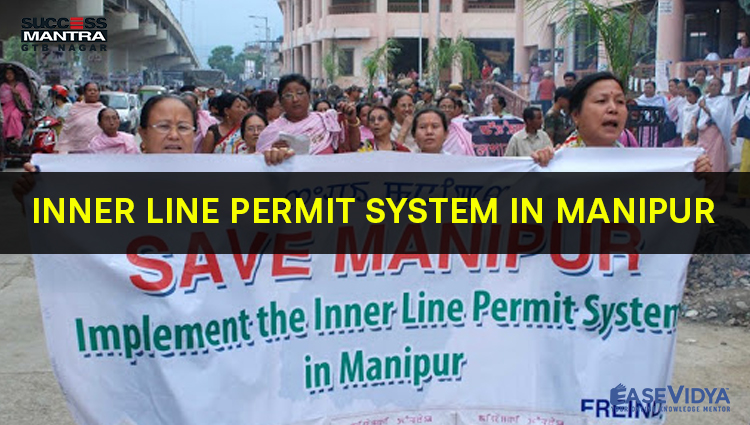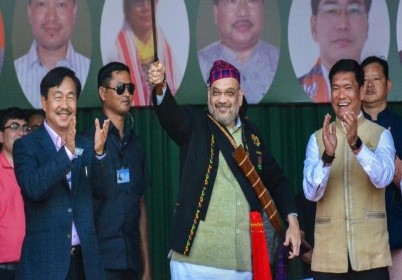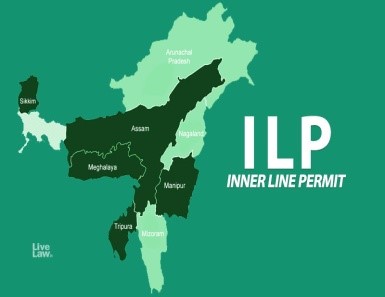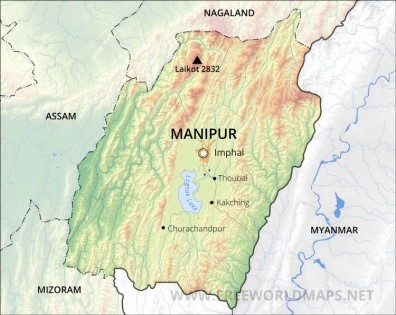
INNER LINE PERMIT SYSTEM IN MANIPUR
INNER LINE PERMIT SYSTEM IN MANIPUR

Recently, the Union Home Minister has highlighted the importance of Inner-Line Permit (ILP) system in Manipur, while inaugurating several development projects in Manipur. The projects include Thoubal Multipurpose Project (Thoubal Dam), Integrated Command and Control Center at Imphal, etc. Thoubal multipurpose project was first considered by the Planning Commission in 1980 and the original cost of the project was Rs. 47.25 crores. A scheme for it was launched in 2004 but nothing happened till 2014 and the project remained on paper. It is located on river Thoubal, a tributary of Manipur River and will irrigate 35,104 hectares.
ILP: DEMAND OF PEOPLE OF MANIPUR
ILP was a long-standing demand of the people of Manipur and denying it would have been an injustice to the indigenous people. Hence, Manipur, along with Dimapur district of Nagaland, was brought under the purview of the ILP System in December 2019. Dimapur was the only place in Nagaland which was not under the ILP system because the district is a commercial hub and has a mixed population (often referred to as ‘Mini India’). Pressure groups in the northeast view this permit as a shield against the entry of illegal immigrants.
Nagaland, Arunachal Pradesh, Manipur and Mizoram were exempted from the provisions of the Citizenship Amendment Act (CAA) 2019 due to the ILP. The provisions on citizenship for illegal migrants would not apply to tribal areas of Assam, Meghalaya, Mizoram or Tripura as included in the Sixth Schedule to the Constitution and the area covered under the ILP system. In December 2019, the Meghalaya Assembly adopted a resolution for implementing the ILP regime in the state and urged the centre to include it in the ILP system.
INNER LINE PERMIT SYSTEM

Implemented under the Bengal Eastern Frontier Regulation (BEFR) 1873, the ILP is an official travel document which allows inward travel of an Indian citizen into a protected/restricted area for a limited period. This Act was enacted during the British era to protect the Crown’s own commercial interests by preventing ‘British subjects’ (Indians) from trading within these regions. In 1950, the Indian government replaced ‘British subjects’ with ‘Citizen of India’. An imaginary line known as the inner-line was created to divide between the two communities so that neither party could go beyond the line without a permit from the appropriate authorities. Under Section 2 of the Regulation of 1873, the ILP was only applicable to the three North-Eastern States viz. Mizoram, Arunachal Pradesh and Nagaland.
On 11th December 2020, the President signed the order extending ILP to Manipur, which became the fourth state where the ILP regime is applicable. It is a special permit obligatorily required by “outsiders” from other regions of the country to enter the notified states. It is issued by the concerned State Government and can be issued for travel purposes solely. Foreigners need a Protected Area Permit (PAP) to visit tourist places which are different from ILPs needed by domestic tourists. Under the Foreigners (Protected Areas) Order 1958, all areas falling between the 'Inner Line', as defined in the said order and the International Border of the State have been declared as a Protected Area. A foreign national is normally not allowed to visit a Protected/Restricted Area unless it is established to the satisfaction of the Government that there are extraordinary reasons to justify such a visit.
As per the Rajya Sabha, the main aim of the ILP system is to prevent any settlement of other Indian citizens within the States where the ILP regime is prevalent. This is done to protect the indigenous/tribal population of that area.
HOW DOES CAA AFFECT THE ILP SYSTEM?
The Citizenship Amendment Act, CAA, relaxes the eligibility criteria for some specific categories of migrants from three countries who seek Indian citizenship. It exempts a few categories of areas which includes all those protected by the Inner Line system. During the protests that were being held against it, the Adaptation of Laws (Amendment) Order, 2019, amended the BEFR, 1873, extending it to Manipur and parts of Nagaland that were not earlier protected by ILP.
SIGNIFICANCE OF THE ILP SYSTEM

• The ILP is considered the only mechanism to put control of the influx in the state. Influx is considered dangerous as it could upset the fragile demographic balance of the tribals of Meghalaya. The indigenous tribes living in the hill areas would regularly be in contact with the outsiders leading to the gradual diminishing of their kind and culture.
• Inner Line Permit is required not only for the conservation of land but also for the culture of the tribes. It, however, is not a permanent solution to any problem of an influx in the North East states. However, the constitution gives the citizens free right to travel anywhere in India but the states where the inner line permit is valid, the citizens require permission to enter and stay.
MERGER OF MANIPUR WITH INDIA
Before 15th August 1947, by peaceful negotiations, the rulers of most of the states signed the ‘Instrument of Accession’ which meant that their state agreed to become a part of the Union of India. The Maharaja of Manipur, Bodhachandra Singh, signed the Instrument of Accession with the Indian government on the assurance that the internal autonomy of Manipur would be maintained. Under the pressure of public opinion, the Maharaja held elections in Manipur in June 1948 and the state became a constitutional monarchy.
Thus, Manipur was the first part of India to hold an election based on universal adult franchise. The Government of India succeeded in pressuring the Maharaja into signing a Merger Agreement in September 1949, without consulting the popularly elected Legislative Assembly of Manipur. On 21st January 1972, Manipur along with Meghalaya and Tripura became full-fledged states under the North Eastern Region (Reorganisation) Act, 1971. The political map of Northeast India underwent a major change and the two Union Territories of Manipur and Tripura and the Sub-State of Meghalaya got statehood.
QUESTIONS (1-5)
Q.1 Recently, Union Home Minister Amit Shah inaugurated Thoubal Multipurpose Project which includes the building of the Thoubal Dam in which of the following North-Eastern states?
A. Meghalaya
B. Tripura
C. Manipur: ANSWER
D. Assam
Q.2 Which of the following statements is/are correct regarding the Inner line permit system?
A. It was implemented under the Bengal Eastern Frontier Regulation (BEFR) 1953.
B. ILP was extended to Manipur in December, 2020: ANSWER
C. Meghalaya was brought under the purview of ILP system in 2015.
D. All of the above
Q.3 Recently, Which of the following districts of Nagaland was brought under the Inner Line permit system by the Union Home Minister Amit Shah?
A. Dimapur: ANSWER
B. Kohima
C. Wokha
D. Khonoma
Q.4 Under Section 2 of the Regulation of 1873, the Inner Line permit system was not applicable to which of the following North-Eastern States?
A. Mizoram
B. Manipur: ANSWER
C. Arunachal Pradesh
D. Nagaland
Q.5 Manipur along with Meghalaya and Tripura became full-fledged states of India under which of the following Acts?
A. North Eastern Region (Reorganization) Act, 1956
B. North Eastern Region (Reorganization) Act, 1965
C. North Eastern Region (Reorganization) Act, 1971: ANSWER
D. None of the above













xwydxhsbhb
INNER LINE PERMIT SYSTEM IN MANIPUR <a href="http://www.g23vzna24o704143120p2goiv1zepp0ws.org/">axwydxhsbhb</a> xwydxhsbhb http://www.g23vzna24o704143120p2goiv1zepp0ws.org/ [url=http://www.g23vzna24o704143120p2goiv1zepp0ws.org/]uxwydxhsbhb[/url]
pxnbwyvgec
INNER LINE PERMIT SYSTEM IN MANIPUR [url=http://www.gu4ke5v3p74mf4142fuv45d9ji5p0t36s.org/]upxnbwyvgec[/url] <a href="http://www.gu4ke5v3p74mf4142fuv45d9ji5p0t36s.org/">apxnbwyvgec</a> pxnbwyvgec http://www.gu4ke5v3p74mf4142fuv45d9ji5p0t36s.org/
qljnsogpo
INNER LINE PERMIT SYSTEM IN MANIPUR qljnsogpo http://www.gcswf314df5206z6t62t6lkt679hvw41s.org/ <a href="http://www.gcswf314df5206z6t62t6lkt679hvw41s.org/">aqljnsogpo</a> [url=http://www.gcswf314df5206z6t62t6lkt679hvw41s.org/]uqljnsogpo[/url]
otgybvckp
INNER LINE PERMIT SYSTEM IN MANIPUR otgybvckp http://www.gzrho90q43x94m547hkb7409w43sivg5s.org/ <a href="http://www.gzrho90q43x94m547hkb7409w43sivg5s.org/">aotgybvckp</a> [url=http://www.gzrho90q43x94m547hkb7409w43sivg5s.org/]uotgybvckp[/url]
rqqdjswmcg
INNER LINE PERMIT SYSTEM IN MANIPUR rqqdjswmcg http://www.gbfd9053cqmipkr6gnd5054y5061c247s.org/ <a href="http://www.gbfd9053cqmipkr6gnd5054y5061c247s.org/">arqqdjswmcg</a> [url=http://www.gbfd9053cqmipkr6gnd5054y5061c247s.org/]urqqdjswmcg[/url]
yhijjpfgyv
INNER LINE PERMIT SYSTEM IN MANIPUR yhijjpfgyv http://www.gi4cq026085h4u6h3374j434bddiqjlos.org/ <a href="http://www.gi4cq026085h4u6h3374j434bddiqjlos.org/">ayhijjpfgyv</a> [url=http://www.gi4cq026085h4u6h3374j434bddiqjlos.org/]uyhijjpfgyv[/url]
khcsnkwwr
INNER LINE PERMIT SYSTEM IN MANIPUR khcsnkwwr http://www.gvwya6l23v816v2r9j75mq2m6pec2126s.org/ <a href="http://www.gvwya6l23v816v2r9j75mq2m6pec2126s.org/">akhcsnkwwr</a> [url=http://www.gvwya6l23v816v2r9j75mq2m6pec2126s.org/]ukhcsnkwwr[/url]
mwqwjoyoir
INNER LINE PERMIT SYSTEM IN MANIPUR <a href="http://www.ge62m63i3v289lthut2uds1a6c9726s5s.org/">amwqwjoyoir</a> mwqwjoyoir http://www.ge62m63i3v289lthut2uds1a6c9726s5s.org/ [url=http://www.ge62m63i3v289lthut2uds1a6c9726s5s.org/]umwqwjoyoir[/url]
efpontjzi
INNER LINE PERMIT SYSTEM IN MANIPUR <a href="http://www.g2e5f42o70gf6a10b003aa34hkq9yh5hs.org/">aefpontjzi</a> [url=http://www.g2e5f42o70gf6a10b003aa34hkq9yh5hs.org/]uefpontjzi[/url] efpontjzi http://www.g2e5f42o70gf6a10b003aa34hkq9yh5hs.org/
dqofwrlwoq
INNER LINE PERMIT SYSTEM IN MANIPUR <a href="http://www.gt498fms188k1od2dvw9n80tt7k220p0s.org/">adqofwrlwoq</a> dqofwrlwoq http://www.gt498fms188k1od2dvw9n80tt7k220p0s.org/ [url=http://www.gt498fms188k1od2dvw9n80tt7k220p0s.org/]udqofwrlwoq[/url]
jobhxybsci
Latest News on Education & LAW Exams Blogs | Success Mantra [url=http://www.gw6s1tl5ubq37w9b4vie78864gxl1207s.org/]ujobhxybsci[/url] <a href="http://www.gw6s1tl5ubq37w9b4vie78864gxl1207s.org/">ajobhxybsci</a> jobhxybsci http://www.gw6s1tl5ubq37w9b4vie78864gxl1207s.org/
byowcjhfy
Latest News on Education & LAW Exams Blogs | Success Mantra <a href="http://www.g6m596c52pvj38941zerhw70dyf9d3v3s.org/">abyowcjhfy</a> [url=http://www.g6m596c52pvj38941zerhw70dyf9d3v3s.org/]ubyowcjhfy[/url] byowcjhfy http://www.g6m596c52pvj38941zerhw70dyf9d3v3s.org/